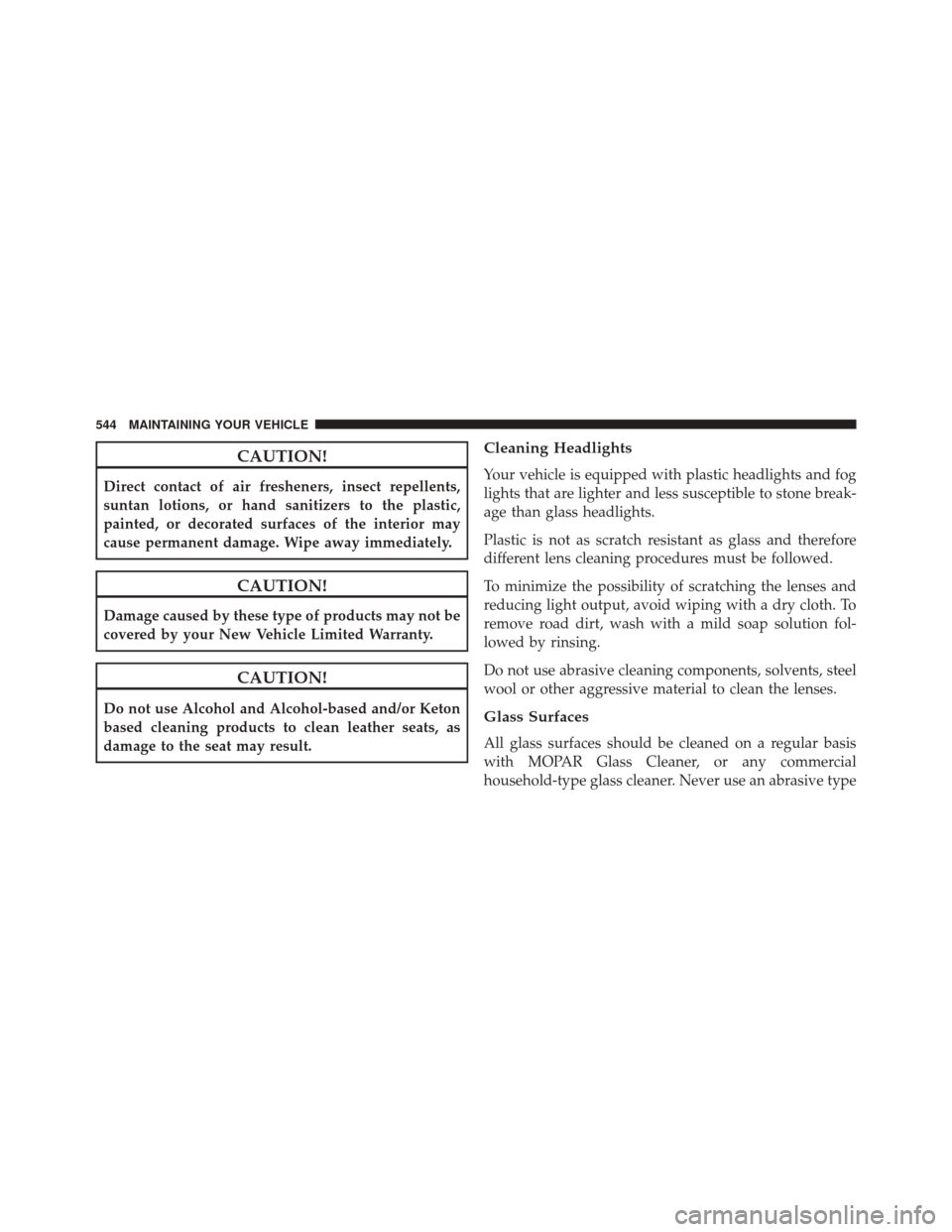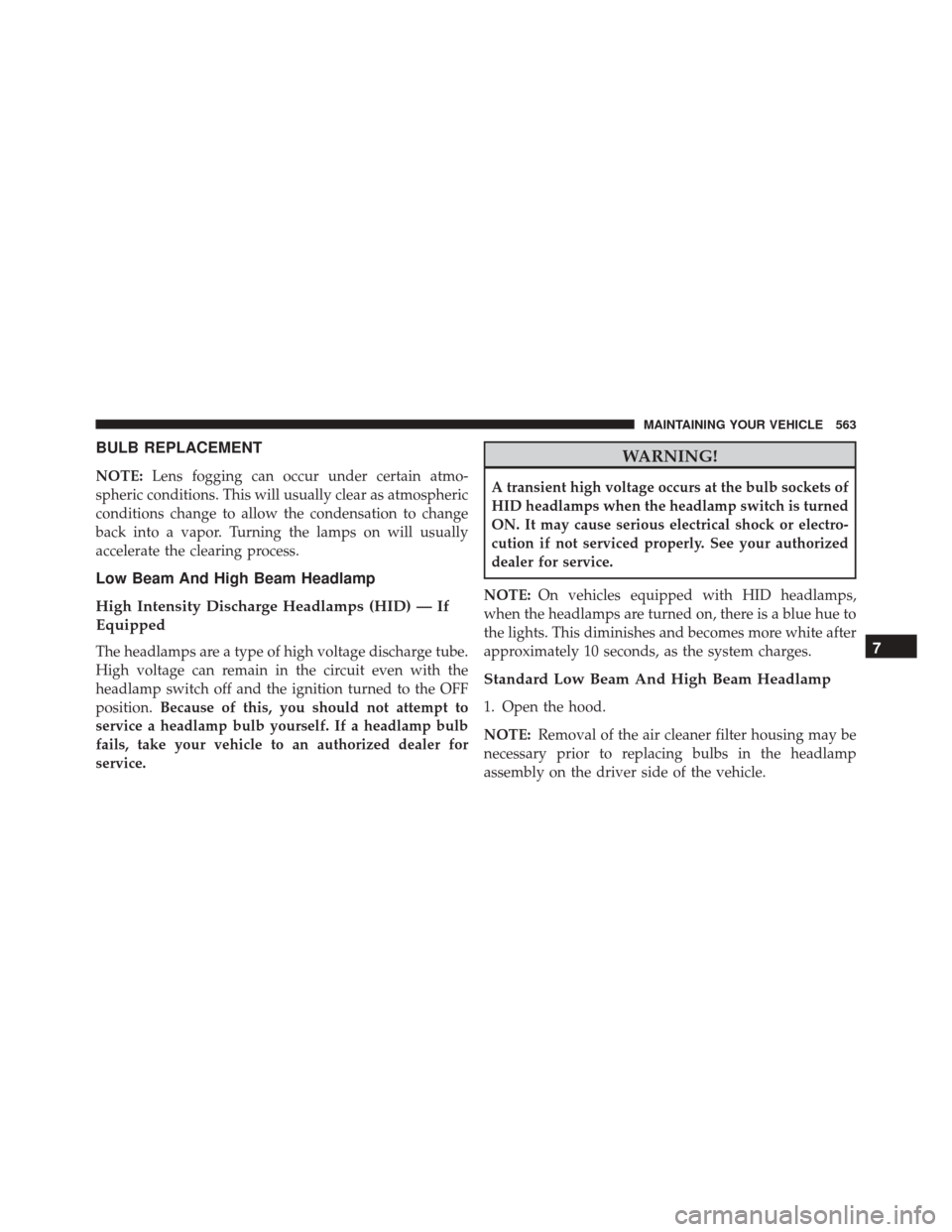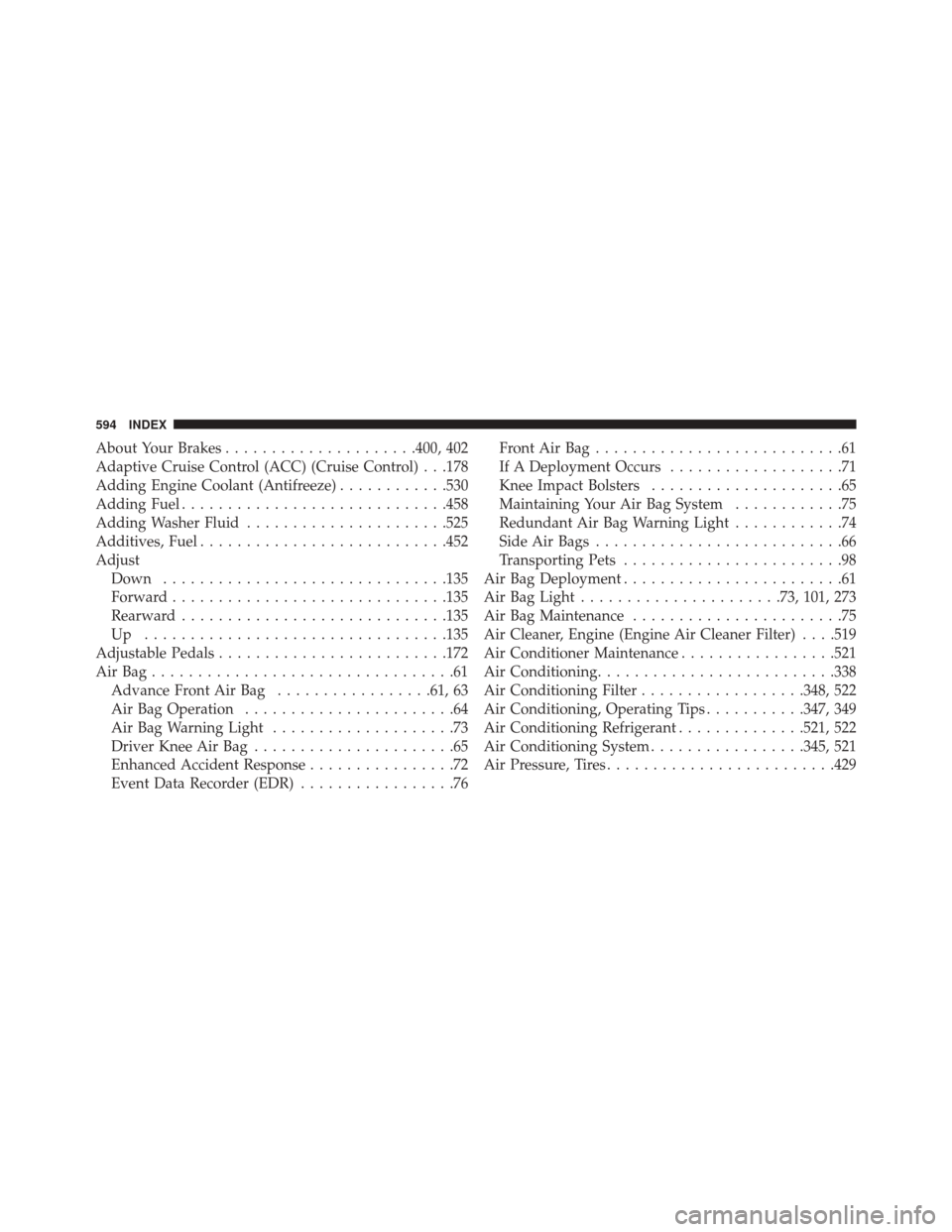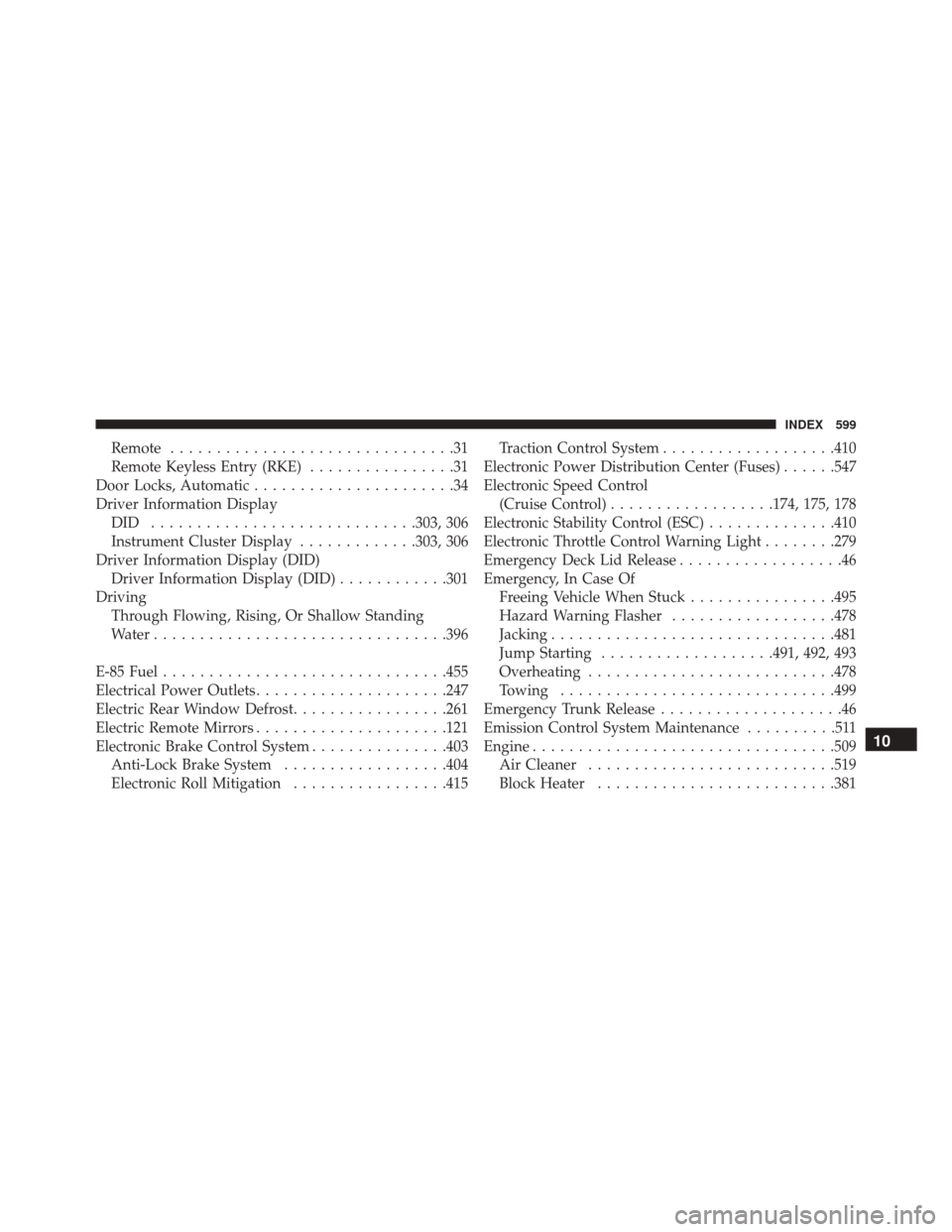2016 CHRYSLER 300 Air cleaner
[x] Cancel search: Air cleanerPage 542 of 620

The following maintenance recommendations will enable
you to obtain maximum benefit from the corrosion
resistance built into your vehicle.
What Causes Corrosion?
Corrosion is the result of deterioration or removal of
paint and protective coatings from your vehicle.
The most common causes are:
•Road salt, dirt and moisture accumulation.
• Stone and gravel impact.
• Insects, tree sap and tar.
• Salt in the air near seacoast localities.
• Atmospheric fallout/industrial pollutants.
Washing
•Wash your vehicle regularly. Always wash your ve-
hicle in the shade using MOPAR Car Wash, or a mild
car wash soap, and rinse the panels completely with
clear water.
• If insects, tar, or other similar deposits have accumu-
lated on your vehicle, use MOPAR Super Kleen Bug
and Tar Remover to remove.
• Use a high quality cleaner wax, such as MOPAR
Cleaner Wax to remove road film, stains and to protect
your paint finish. Take care never to scratch the paint.
• Avoid using abrasive compounds and power buffing
that may diminish the gloss or thin out the paint finish.
540 MAINTAINING YOUR VEHICLE
Page 546 of 620

CAUTION!
Direct contact of air fresheners, insect repellents,
suntan lotions, or hand sanitizers to the plastic,
painted, or decorated surfaces of the interior may
cause permanent damage. Wipe away immediately.
CAUTION!
Damage caused by these type of products may not be
covered by your New Vehicle Limited Warranty.
CAUTION!
Do not use Alcohol and Alcohol-based and/or Keton
based cleaning products to clean leather seats, as
damage to the seat may result.
Cleaning Headlights
Your vehicle is equipped with plastic headlights and fog
lights that are lighter and less susceptible to stone break-
age than glass headlights.
Plastic is not as scratch resistant as glass and therefore
different lens cleaning procedures must be followed.
To minimize the possibility of scratching the lenses and
reducing light output, avoid wiping with a dry cloth. To
remove road dirt, wash with a mild soap solution fol-
lowed by rinsing.
Do not use abrasive cleaning components, solvents, steel
wool or other aggressive material to clean the lenses.
Glass Surfaces
All glass surfaces should be cleaned on a regular basis
with MOPAR Glass Cleaner, or any commercial
household-type glass cleaner. Never use an abrasive type
544 MAINTAINING YOUR VEHICLE
Page 565 of 620

BULB REPLACEMENT
NOTE:Lens fogging can occur under certain atmo-
spheric conditions. This will usually clear as atmospheric
conditions change to allow the condensation to change
back into a vapor. Turning the lamps on will usually
accelerate the clearing process.
Low Beam And High Beam Headlamp
High Intensity Discharge Headlamps (HID) — If
Equipped
The headlamps are a type of high voltage discharge tube.
High voltage can remain in the circuit even with the
headlamp switch off and the ignition turned to the OFF
position. Because of this, you should not attempt to
service a headlamp bulb yourself. If a headlamp bulb
fails, take your vehicle to an authorized dealer for
service.
WARNING!
A transient high voltage occurs at the bulb sockets of
HID headlamps when the headlamp switch is turned
ON. It may cause serious electrical shock or electro-
cution if not serviced properly. See your authorized
dealer for service.
NOTE: On vehicles equipped with HID headlamps,
when the headlamps are turned on, there is a blue hue to
the lights. This diminishes and becomes more white after
approximately 10 seconds, as the system charges.
Standard Low Beam And High Beam Headlamp
1. Open the hood.
NOTE: Removal of the air cleaner filter housing may be
necessary prior to replacing bulbs in the headlamp
assembly on the driver side of the vehicle.
7
MAINTAINING YOUR VEHICLE 563
Page 566 of 620

2. Reach behind the headlamp housing to access theheadlamp (outboard) bulb cap.
3. Firmly grasp the cap and rotate it counterclockwise to unlock it.
4. Twist the headlamp bulb assembly counterclockwise, and then pull it out of the headlamp assembly.
5. Disconnect the bulb from the wiring assembly and install the replacement bulb.
6. Reinstall the bulb and wiring assembly into the head- lamp assembly, and then turn it clockwise.
7. Install the headlamp bulb cap in the headlamp hous- ing and rotate it clockwise to lock it.CAUTION!
Do not touch the new bulb with your fingers. Oil
contamination will severely shorten bulb life. If the
bulb comes in contact with an oily surface, clean the
bulb with rubbing alcohol.
Front Turn Signal Lamps
1. Open the hood.
NOTE: Removal of the air cleaner filter housing may be
necessary prior to replacing bulbs in the headlamp
assembly on the driver side of the vehicle.
2. Reach behind the headlamp housing to access the turn signal (inboard) bulb cap.
3. Firmly grasp the cap and rotate it counterclockwise to unlock it.
564 MAINTAINING YOUR VEHICLE
Page 577 of 620

Severe Duty All Models
Change Engine Oil at 4,000 miles (6,500 km) if the vehicle
is operated in a dusty and off road environment or is
operated predominantly at idle or only very low engine
RPM’s. This type of vehicle use is considered Severe
Duty.
Once A Month Or Before A Long Trip:
•Check engine oil level.
• Check windshield washer fluid level.
• Check tire pressure and look for unusual wear or
damage. Rotate tires at the first sign of irregular wear,
even if it occurs before your next scheduled service.
• Check the fluid levels of the coolant reservoir, brake
master cylinder, and power steering (if equipped) and
fill as needed.
• Check function of all interior and exterior lights. Required Maintenance Intervals:
Refer to the maintenance schedules on the following
page for the required maintenance intervals.
At Every Oil Change Interval As Indicated By Oil
Change Indicator System:
•Change oil and filter
• Rotate the tires.
Rotate at the first sign of irregular
wear, even if it occurs before your next scheduled service
• Inspect battery and clean and tighten terminals as
required
• Inspect brake pads, shoes, rotors, drums, hoses
and park brake
•
Inspect engine cooling system protection and hoses
• Inspect exhaust system
• Inspect engine air cleaner if using in dusty or
off-road conditions 8
MAINTENANCE SCHEDULES 575
Page 596 of 620

About Your Brakes.....................400, 402
Adaptive Cruise Control (ACC) (Cruise Control) . . .178
Adding Engine Coolant (Antifreeze) ............530
Adding Fuel ............................ .458
Adding Washer Fluid ..................... .525
Additives, Fuel .......................... .452
Adjust Down .............................. .135
Forward ............................. .135
Rearward ............................ .135
Up ................................ .135
Adjustable Pedals ........................ .172
AirBag.................................61 Advance Front Air Bag .................61, 63
Air Bag Operation .......................64
Air Bag Warning Light ....................73
Driver Knee Air Bag ......................65
Enhanced Accident Response ................72
Event Data Recorder (EDR) .................76 FrontAirBag...........................61
If A Deployment Occurs
...................71
Knee Impact Bolsters .....................65
Maintaining Your Air Bag System ............75
Redundant Air Bag Warning Light ............74
Side Air Bags ...........................66
Transporting Pets ........................98
Air Bag Deployment ........................61
Air Bag Light ..................... .73, 101, 273
Air Bag Maintenance .......................75
Air Cleaner, Engine (Engine Air Cleaner Filter) . . . .519
Air Conditioner Maintenance .................521
Air Conditioning ......................... .338
Air Conditioning Filter ..................348, 522
Air Conditioning, Operating Tips ...........347, 349
Air Conditioning Refrigerant ..............521, 522
Air Conditioning System .................345, 521
Air Pressure, Tires ........................ .429
594 INDEX
Page 601 of 620

Remote...............................31
Remote Keyless Entry (RKE) ................31
Door Locks, Automatic ......................34
Driver Information Display DID ............................ .303, 306
Instrument Cluster Display .............303, 306
Driver Information Display (DID) Driver Information Display (DID) ............301
Driving Through Flowing, Rising, Or Shallow Standing
Water ............................... .396
E-85 Fuel .............................. .455
Electrical Power Outlets .....................247
Electric Rear Window Defrost .................261
Electric Remote Mirrors .....................121
Electronic Brake Control System ...............403
Anti-Lock Brake System ..................404
Electronic Roll Mitigation .................415 Traction Control System
...................410
Electronic Power Distribution Center (Fuses) ......547
Electronic Speed Control (Cruise Control) ..................174, 175, 178
Electronic Stability Control (ESC) ..............410
Electronic Throttle Control Warning Light ........279
Emergency Deck Lid Release ..................46
Emergency, In Case Of Freeing Vehicle When Stuck ................495
Hazard Warning Flasher ..................478
Jacking .............................. .481
Jump Starting ...................491, 492, 493
Overheating .......................... .478
Towing ............................. .499
Emergency Trunk Release ....................46
Emission Control System Maintenance ..........511
Engine ................................ .509
Air Cleaner .......................... .519
Block Heater ......................... .381
10
INDEX 599
Page 602 of 620

Break-In Recommendations.................99
Checking Oil Level ...................514, 515
Compartment ...................... .508, 509
Compartment Identification ................508
Coolant (Antifreeze) ...........528, 568, 569, 570
Cooling ............................. .528
Exhaust Gas Caution .................100, 454
Fails To Start ......................... .380
Flooded, Starting ...................... .380
Fuel Requirements ..................... .450
Jump Starting ...................491, 492, 493
Oil ....................514, 566, 568, 569, 570
Oil Filler Cap ......................... .517
Oil Filter ............................ .518
Oil Selection ...................... .516, 566
Oil Synthetic ......................... .518
Overheating .......................... .478
Starting ............................. .376
Engine Oil Viscosity ...................... .517Engine Oil Viscosity Chart
...................517
Enhanced Accident Response Feature ............72
Entry System, Illuminated ....................21
Ethanol ............................ .451, 455
Event Data Recorder ........................76
Exhaust Gas Caution ...................100, 454
Exhaust System ...................... .100, 526
Exterior Folding Mirrors ....................119
Exterior Lighting ......................... .152
Exterior Lights .......................... .103
Filters Air Cleaner .......................... .519
Air Conditioning ....................348, 522
Engine Oil ..................518, 568, 569, 570
Engine Oil Disposal .....................518
Flashers Hazard Warning ....................... .478
Turn Signal .....................103, 158, 297
600 INDEX